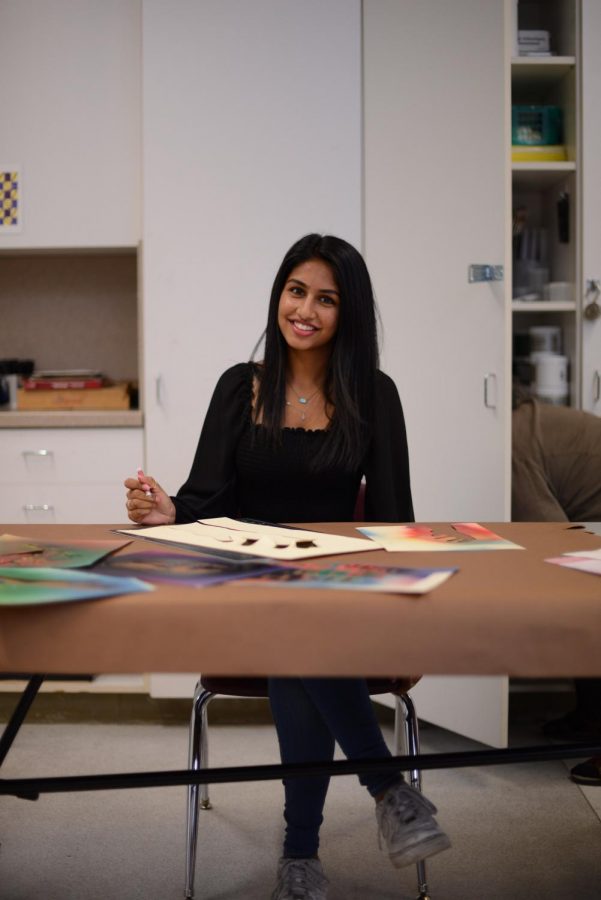Humans of Harker: Find your inner artist
Zara Vakath (12) expresses her beliefs and helps others through art
“Art is a vehicle for positive change in some way. It’s an easy way to spark conversation about topics that are too difficult to maybe address or talk about otherwise. I think that’s something I’ve really endeavored to do. I do my art especially because I’m inspired by other artists who do the same thing, artists who use their art to confront controversies and incite discussion about things that are difficult,” Zara Vakath (12) said.
With a paintbrush in her hand, Zara Vakath (12) stares decisively at the white canvas. After dipping her paintbrush into bright, textured oil paints, she lifts it up to the canvas. Without thinking, her hand flicks, leaving a smooth brushstroke of the bright paint on the canvas.
At the age of six, Zara attended her first art class. While she has been an artist all her life, in high school, other activities took priority until her sophomore year. With an extra elective space, Zara decided to take an art class where she rediscovered her passion for art.
“That was the first time where I really had to share my art because my art teacher focuses on a collaborative and constructive learning approach where you share your work and get feedback from others. This workshopping process was the first time that I had to share my art, and it [took me] out of my comfort zone,” Zara said.
Zara’s passion for art sparked from her inspiration from other artists and from the idea that art would be a way of expressing ideas.
“Art is a vehicle for positive change in some way. It’s an easy way to spark conversation about topics that are too difficult to maybe address or talk about otherwise. I think that’s something I’ve really endeavored to do,” Zara said. “I do my art especially because I’m inspired by other artists who do the same thing, artists who use their art to confront controversies and incite discussion about things that are difficult.”
Zara’s friends recognize her dedication and passion for art. Kismet Singh (12) expressed that Zara always works hard to be successful.
“I would describe Zara as super smart and dedicated … She’s set on achieving her goals no matter what’s in her way,” Kismet said.
Ayla Tanurhan (12), Zara’s close friend, acknowledges Zara’s dedication and beliefs as great advantages for her success in the future.
“Zara really knows what she wants and isn’t afraid to go after it. She has this very particular image of what her future looks like and she just knows that she’s going to get there. I really admire her belief that everything works out the way it is supposed to,” Ayla said.
Zara has shown her dedication through the creation of her own art nonprofit organization. In her junior year, Zara came up with the idea of this organization after teaching her neighbor some basic art skills.
“My next-door neighbor … whose doctor actually recommended that she pursue creative activities to help with her blood pressure talked to me. I got her started with some beginner painting materials,” Zara said. “Soon after, she ended up actually improving her physical health a lot, and she swears it was attributed to her newfound love for art.”
Throughout the years of doing art, Zara has noticed a positive and modern change in it, especially regarding science.
“There has been a really cool shift in modern medicine, towards having an emphasis on mental health and not just that, but also like exploring other avenues for healing such as art, which I think is really great and positive change in medicine,” Zara said.
This modernization encouraged Zara to help others through art. Zara’s organization holds therapeutic workshops for children and for seniors who typically have Alzheimer’s disease.
“I do this one workshop for children with autism where you drop ink on a paper and then use a straw to blow it and make branches like a tree. Then they paint leaves. The idea behind it is that instead of telling the child, ‘Hey, we’re sending you to speech therapy,’ they get to do an activity that helps with breath control, and therefore helps with speech therapy,” Zara said.
After high school, Zara plans on continuing her organization in college. She hopes to recruit new volunteers in college.
“If there’s some way to start a branch at the college I go to as a student organization, I’d love to do that because I’ve already actually like gotten my friends involved. They’ve actually helped me with my workshops before, and I think it’d be really cool if I could get a lot of volunteers on board and like do it as a student organization in the college,” Zara said.
As she moves on past high school, Zara hopes to continue using her creative side, even though she does not plan on going to art school.
“I think the biggest goal I have when I think about my future is that no matter what career path I go down, I want to find some way to use the creative side of me. That is really important to who I am and to my identity,” Zara said. “I might want to pursue business and I feel like I’d love to do something like in the entertainment sector or in a field like that, where I still get to be creative, even if I’m not literally doing art every day.”

Ritika Rajamani (12) is the Business Manager of the TALON Yearbook, and this is her fourth year on staff. This year she hopes to connect with our seniors...


















![“[Building nerf blasters] became this outlet of creativity for me that hasn't been matched by anything else. The process [of] making a build complete to your desire is such a painstakingly difficult process, but I've had to learn from [the skills needed from] soldering to proper painting. There's so many different options for everything, if you think about it, it exists. The best part is [that] if it doesn't exist, you can build it yourself," Ishaan Parate said.](https://harkeraquila.com/wp-content/uploads/2022/08/DSC_8149-900x604.jpg)




![“When I came into high school, I was ready to be a follower. But DECA was a game changer for me. It helped me overcome my fear of public speaking, and it's played such a major role in who I've become today. To be able to successfully lead a chapter of 150 students, an officer team and be one of the upperclassmen I once really admired is something I'm [really] proud of,” Anvitha Tummala ('21) said.](https://harkeraquila.com/wp-content/uploads/2021/07/Screen-Shot-2021-07-25-at-9.50.05-AM-900x594.png)







![“I think getting up in the morning and having a sense of purpose [is exciting]. I think without a certain amount of drive, life is kind of obsolete and mundane, and I think having that every single day is what makes each day unique and kind of makes life exciting,” Neymika Jain (12) said.](https://harkeraquila.com/wp-content/uploads/2017/06/Screen-Shot-2017-06-03-at-4.54.16-PM.png)








![“My slogan is ‘slow feet, don’t eat, and I’m hungry.’ You need to run fast to get where you are–you aren't going to get those championships if you aren't fast,” Angel Cervantes (12) said. “I want to do well in school on my tests and in track and win championships for my team. I live by that, [and] I can do that anywhere: in the classroom or on the field.”](https://harkeraquila.com/wp-content/uploads/2018/06/DSC5146-900x601.jpg)
![“[Volleyball has] taught me how to fall correctly, and another thing it taught is that you don’t have to be the best at something to be good at it. If you just hit the ball in a smart way, then it still scores points and you’re good at it. You could be a background player and still make a much bigger impact on the team than you would think,” Anya Gert (’20) said.](https://harkeraquila.com/wp-content/uploads/2020/06/AnnaGert_JinTuan_HoHPhotoEdited-600x900.jpeg)

![“I'm not nearly there yet, but [my confidence has] definitely been getting better since I was pretty shy and timid coming into Harker my freshman year. I know that there's a lot of people that are really confident in what they do, and I really admire them. Everyone's so driven and that has really pushed me to kind of try to find my own place in high school and be more confident,” Alyssa Huang (’20) said.](https://harkeraquila.com/wp-content/uploads/2020/06/AlyssaHuang_EmilyChen_HoHPhoto-900x749.jpeg)



